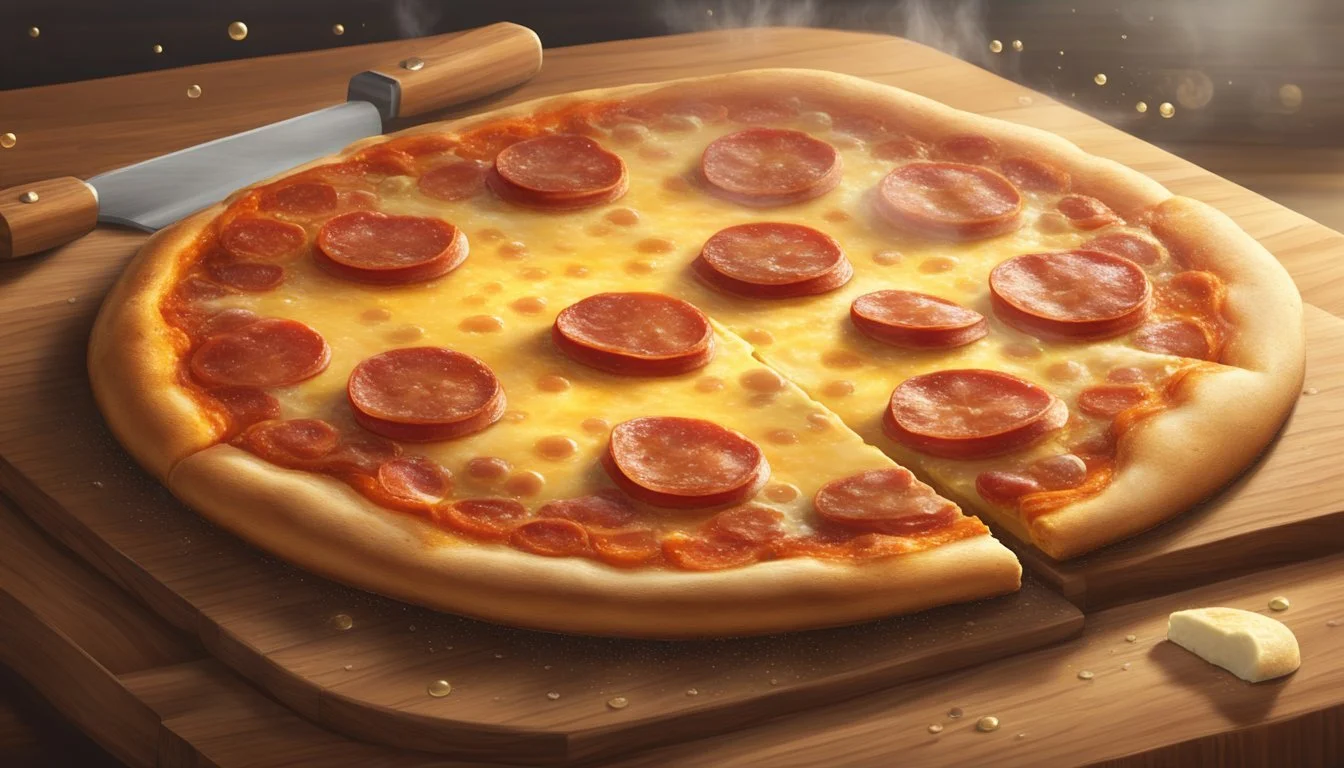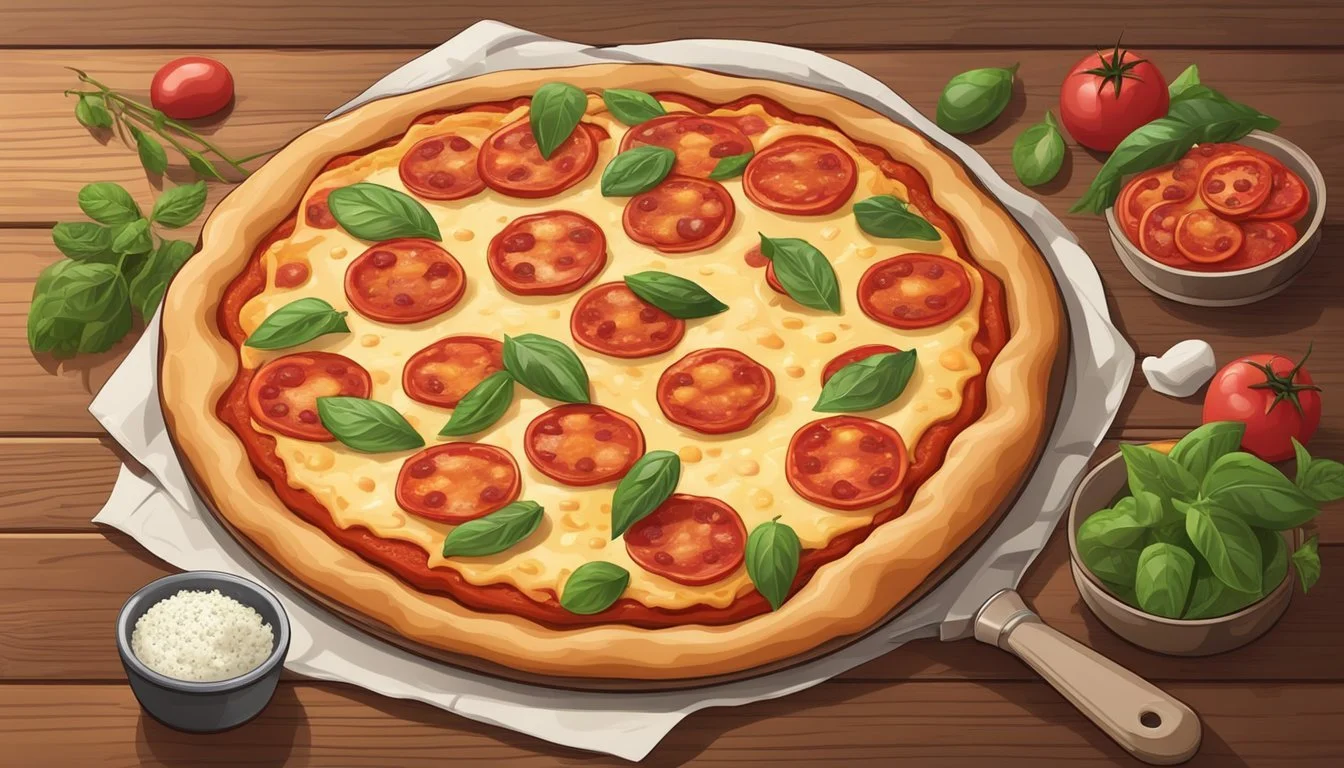How Long Does Gluten-Free Pepperoni Pizza Last?
Storage Tips and Safety
When it comes to storing gluten-free pepperoni pizza, understanding its shelf life is crucial for maintaining freshness and safety. Typically, a freshly made gluten-free pepperoni pizza can last in the refrigerator for up to 3-4 days if stored properly in an airtight container. For longer storage, freezing the pizza can extend its life to about 1-2 months without significant loss of quality.
Proper storage not only extends the lifespan of gluten-free pepperoni pizza but also helps retain its taste and texture. It's important to note that freezing the pizza soon after it's made or purchased preserves its flavors better. To reheat, preheat your oven to 375°F and bake until the cheese is bubbly and the crust is crisp, usually taking about 10-15 minutes.
Adhering to these storage tips ensures that your gluten-free pepperoni pizza remains safe and delicious. Always check for signs of spoilage such as an off smell or mold, which indicate that the pizza should not be consumed. This approach keeps the pizza enjoyable for a longer period, eliminating waste and making meal planning easier.
Understanding Gluten-Free Pizza
Gluten-free pizza is crafted with alternative ingredients to replace traditional wheat flour, ensuring it is safe for individuals with gluten sensitivity or celiac disease. It involves careful selection of components and diligent preparation to avoid cross-contamination.
Ingredients and Alternatives
Gluten-free pizza typically uses gluten-free flour made from rice, almonds, corn, or beans. Combining different flours, like rice flour and tapioca starch, enhances texture and flavor. Xanthan gum is often added to provide elasticity and structure, mimicking the properties of gluten.
The dough may include yeast to help it rise, along with egg and olive oil to bind the ingredients and achieve a desired consistency. These combinations ensure a crust that is both tasty and safe for those avoiding gluten.
Benefits for Celiac Disease and Gluten Sensitivity
Individuals with celiac disease or gluten sensitivity benefit significantly from gluten-free pizza. Consuming traditional gluten can trigger severe reactions, but gluten-free variants eliminate this risk. Gluten-free pizzas use safe ingredients and are prepared following strict allergen information guidelines.
Proper management of gluten intake helps prevent complications like digestive distress, nutrient deficiencies, and long-term intestinal damage. By adhering to gluten-free diets, those affected can enjoy pizza without negative health impacts.
Ensuring the pizza is free from cross-contamination is critical. This means preparing the dough, toppings, and baking on clean surfaces and using dedicated utensils. This diligence guarantees the safety and enjoyment of gluten-free pizza.
Making Gluten-Free Pepperoni Pizza
Creating a great gluten-free pepperoni pizza involves careful attention to both homemade preparation and understanding commercial options. Essential elements include the choice of gluten-free flour, active dry yeast, and the right cooking methods for a perfect crust.
Homemade Pizza Crafting
When making gluten-free pepperoni pizza at home, start by gathering key ingredients like gluten-free flour, active dry yeast, and toppings such as pepperoni and cheese. Preheat the oven to around 450°F for a crispy crust.
Mix water, active dry yeast, and often a bit of honey, letting it sit until frothy. Combine gluten-free flour, arrowroot powder, salt, and garlic powder in a bowl. Stir in an egg and some olive oil, then add the yeast mixture to form a dough ball.
Roll the dough into even balls and flatten them into discs. Roll each piece out to about 12 inches in diameter and 1/16 inch thick. Place the dough on a baking sheet with parchment paper.
Pre-bake the crust for a few minutes before adding your sauce, cheese, and pepperoni. Bake until the crust is golden and the cheese is bubbly, which usually takes around 10-15 minutes.
Commercial Gluten-Free Options
For those short on time, supermarkets offer various ready-made gluten-free pepperoni pizzas. These range from frozen pizzas to fresh options pre-made by local or national brands.
Most commercial brands use a mix of gluten-free flours and pre-cook the crust to ensure it maintains a good texture when reheated. Check labels for gluten-free certification to avoid cross-contamination.
Manufacturers typically recommend baking these pizzas directly on the oven rack for even heating. Cooking times can vary, generally around 10-15 minutes at high temperatures (450°F), delivering a crisp crust and evenly melted cheese. Experiment with different brands to find the best gluten-free pepperoni pizza that suits your taste.
Key Ingredients for Flavor and Texture
Creating a delicious gluten-free pepperoni pizza relies heavily on the choice of ingredients and how they contribute to both flavor and texture. Key components include the selection of cheese and toppings, alongside the sauce and spices used.
Cheese Choices and Toppings
The type of cheese used on a gluten-free pepperoni pizza greatly influences its flavor and texture. Mozzarella is the most common choice because of its excellent melting properties and mild flavor. Opting for part-skim mozzarella can provide a less greasy surface, while shredded mozzarella ensures even coverage over the pizza.
Parmesan cheese can be added to enhance the savory taste profile. For those looking to mix flavors, a blend of mozzarella and parmesan can offer a rich, creamy texture with a hint of nuttiness.
Toppings like pepperoni are critical for traditional flavor. For added color and flavor complexity, bell peppers, mushrooms, and onions are popular additions. Olives and artichokes can also provide unique flavors.
Sauce and Spices
Tomato sauce serves as the foundation for taste. Using a sauce made from ripe tomatoes, combined with a hint of sweetness and acidity, delivers a balanced flavor. A good pizza sauce will incorporate garlic for depth, and possibly a bit of olive oil for richness.
Spices are essential to build complexity in taste. Oregano and basil are staples of Italian seasoning blends, providing aromatic notes that complement the tomato base. Crushed red pepper flakes can be added for a hint of heat.
To add even more depth, consider using a small amount of thyme or rosemary. These herbs introduce earthy undertones, enhancing the overall flavor without overshadowing the other ingredients.
Storing Gluten-Free Pepperoni Pizza
Proper storage practices can significantly extend the life of gluten-free pepperoni pizza, whether it's leftover or freshly bought. Key considerations include refrigeration guidelines, freezing methods, and recognizing spoilage indicators.
Refrigeration and Freezing Guidelines
Refrigeration: Leftover gluten-free pepperoni pizza should be placed in the fridge promptly. Ensure it is sealed in an airtight container or wrapped snugly in plastic wrap to minimize air exposure and moisture loss. Stored this way, it can last 3 to 4 days.
Freezing: To store for longer, freeze the pizza. Place slices on a baking sheet until solid, then transfer to a freezer-safe bag or container. This technique prevents slices from sticking together. Frozen pizza maintains best quality for 1-2 months. Thaw in the fridge overnight before reheating. Avoid refreezing thawed pizza to preserve texture and flavor.
Shelf Life and Spoilage Indicators
Shelf Life: The shelf life of gluten-free pepperoni pizza varies by storage method. In the fridge, expect up to 4 days of safe consumption. Freezing can extend usability to 2 months, though the quality may decline slightly over time.
Spoilage Indicators: Spoiled pizza shows clear signs like mold, off odors, and unusual texture changes. If it smells sour or the cheese has a slimy appearance, discard immediately to avoid bacteria-related illnesses. Checking for any odd spots or discoloration also helps in assessing spoilage. Clearly label containers with dates to track storage duration and ensure safe consumption.
Consumption and Health Considerations
A gluten-free pepperoni pizza offers alternative nutritional values and critical considerations for those with specific dietary restrictions or allergies. Knowing these elements is essential for making informed consumption choices.
Nutritional Values
Gluten-free pepperoni pizza typically contains a different nutritional profile compared to its traditional counterparts. Calories per slice range from 250 to 300, influenced by toppings like pepperoni and sausage, known for higher fat content.
The crust, made from alternative grains or flours such as rice or tapioca, contains less fiber but maintains a lower protein content. Adding cheeses and meats increases the overall nutritional impact, such as additional calories and fat.
Nutritional Table:
Component Amount per Slice Calories 250 - 300 Protein 10 - 15 grams Fat 10 - 20 grams Fiber 1 - 2 grams
Dietary Restrictions and Allergies
Individuals with celiac disease or gluten sensitivity benefit greatly from gluten-free options. Traditional pizza crusts derived from wheat or rye can cause adverse reactions, making gluten-free alternatives a safer option.
It is crucial to check allergen information on any gluten-free pepperoni pizza product. Ingredients such as cheese might contain casein, another potential allergen. Additionally, cross-contamination risks in non-dedicated gluten-free facilities can pose hidden dangers for strict gluten-free diets.
Gluten-free pizzas may have fewer digestive issues for sensitive individuals, thus enhancing their dining experience without compromising health. This makes them a viable option for family gatherings where dietary needs vary.
Final Thoughts and Recommendations
When considering the longevity of gluten-free pepperoni pizza, it's essential to focus on selecting high-quality ingredients and reviewing consumer choices to ensure the best experience.
Selecting High-Quality Ingredients
Choosing the right ingredients is crucial for both taste and longevity of gluten-free pepperoni pizza. High-quality pepperoni provides a rich, savory flavor. Opting for pre-sliced deli meat from a trusted supermarket ensures convenience without sacrificing quality.
Cheese selection impacts both texture and taste. Using mozzarella blended with a bit of aged Parmesan can enhance the flavor profile.
Incorporating fresh ingredients like olive oil and fresh basil can elevate the pizza's taste. Olive oil adds richness, while fresh basil provides a refreshing contrast to the savory pepperoni and cheese.
Pizza Review and Consumer Choices
For those seeking convenience, frozen gluten-free pepperoni pizzas like those from DiGiorno or Freschetta offer easy preparation and consistent quality. These brands have dedicated gluten-free production processes which cater to consumer needs.
Homemade gluten-free pizzas allow for customization in taste and consistency. This option lets families control ingredients, ensuring top-notch quality while avoiding preservatives found in some store-bought options.
Reviewing different brands and consumer feedback helps in making informed decisions. Opinions on texture and taste vary, so experimenting with a few options may be beneficial. Consider aspects like crust thickness and cheese melt quality when reading reviews.
Informed choices regarding ingredients and consumer preferences result in a gluten-free pepperoni pizza that is enjoyable and lasts longer, preserving both quality and taste.







